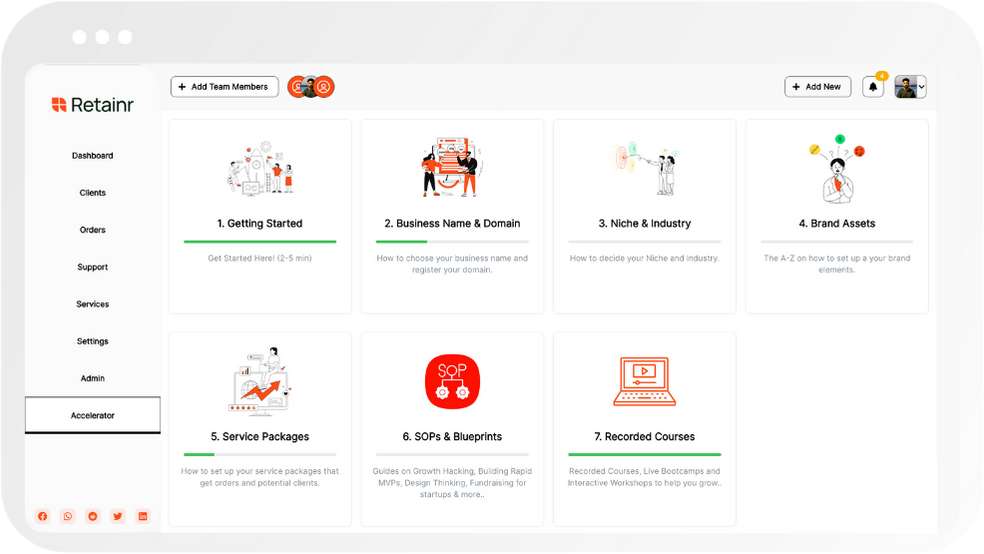
15 Time-Saving Tips for Small Business Productivity
Build with Retainr
Sell your products and services, manage clients, orders, payments, automate your client onboarding and management with your own branded web application.
Get Started1. What are the top 15 time-saving tips for improving small business productivity?
Top 5 Time-Saving Tips for Small Business Productivity
Improving productivity in a small business can be achieved with these five time-saving tips:
- Utilize Software Tools: Employ the use of efficient software tools that automate tasks such as accounting, project management, and customer relations management. This minimizes the time taken to accomplish tasks manually.
- Outsource Non-core Activities: Businesses can focus on core activities by outsourcing tasks like administration. This allows more time and energy to be devoted to other important areas.
- Adopt Agile Practices: Agile practices like Scrum and Kanban help break down tasks into manageable units, thus making project management more efficient.
- Set Realistic Goals: Setting clear and achievable goals helps employees to focus and prioritize their work, thereby increasing productivity.
- Online Meetings: The use of online meetings reduces travel time and allows instant communication with team members irrespective of their location.
Next 5 Time-Saving Tips
Following are the next five effective tips which can further boost business productivity:
| Tip | Description |
|---|---|
| Batch Processing | Enables you to handle similar tasks together to enhance concentration and effectiveness. |
| Time Blocking | Aids in dedicating specific time intervals for significant jobs thereby reducing fluctuations and interruptions. |
| Wireless Technology | Enables you to work remotely and collaborate efficiently. |
| Email Management | Segmenting your email into different categories can prevent constant inbox checking, which wastes significant time. |
| Flexible work hours | By adopting flexible work hours, employees can work at peak productivity hours. |
Final set of Time-Saving Tips
The final five tips ensure the smooth running and maximum output of your small business:
- Regular Breaks: Short regular breaks can revitalize your staff, making them more productive.
- Training: Regular training of staff on time management and efficient working practices can significantly boost productivity.
- Avoid Multitasking: Though it may seem like you're getting more done, multitasking can often lead to mistakes and a decline in the quality of work.
- E-Commerce Integration: Integrating your business with e-commerce can save time with handling orders and managing inventory.
- Streamline Communication: Efficient internal communication systems can save time in scheduling, task allocation, and overall team coordination.
2. How can these time-saving tips contribute to the growth of a small business?
Time-Saving Tips Contribution to Business Growth
Time-saving tips can significantly contribute to the growth of a small business in several ways. The impact resonates from the management levels to the junior staff, influencing overall productivity and efficiency. A few of these benefits include:
- Improvement in services: Saving time stimulates an environment where services rendered by the business improve significantly. Businesses are more equipped to meet deadlines and deliver efficient services.
- Maximizing profit: The quicker the turnaround time for tasks, the greater the potential for increased revenue. Time-saving methods enable processes to be streamlined and more tasks to be achieved, directly influencing profit.
- Boosting employee morale: By incorporating time-saving techniques, employees experience reduced stress and an improved work-life balance. This can heighten motivation and performance, which strengthens the business.
Applying Time-Saving Techniques
An essential aspect of implementing time-saving tips is determining which methods align with business objectives. These may vary from simple changes such as consolidating meetings or outsourcing repetitive tasks to more technical implementations of software or automation processes. Here’s an example of some preferred time-saving techniques:
| Technique | Description |
|---|---|
| Usage of Productivity Tools | Software applications designed to enhance productivity through task management, communication and collaboration. |
| Outsourcing Non-Core Tasks | Shifting responsibilities of non-core business functions to external agencies, freeing up time and resources. |
| Schedule Consolidation | Aiming to hold multiple meetings in a day or back-to-back to reduce preparation time and improve time management. |
Establishing a Time Management Strategy
As much as the benefits of time-saving tips are attractive, the transition to them should be deliberate, thoughtful, and strategy-based. A rushed move could counterproductively lead to losses. Here are a few steps towards implementing these strategies:
- Conduct an audit to evaluate what is needed and what can be improved in the company’s current processes and decide which tips to adopt accordingly.
- Communicate clearly what the changes will be, how they will be implemented, and what is expected of employees during this transition.
- Seek regular feedback to understand what is working and what requires tweaking.
3. Are these productivity tips applicable to every form of small business?
Applicability of Productivity Tips across Various Small Businesses
While certain productivity tips may be tailored for specific industries, the majority of these time-saving techniques can be utilized by a wide range of small businesses. Their broad utility lies in their focus on the fundamental aspects of running a successful business: organization, prioritization, communication, and efficiency.
- Online businesses: Whether it's a web development agency, an e-commerce store, or affiliate marketing business, tips related to streamlining communication, delegating tasks, or utilizing productivity tools are equally relevant.
- Retail / Brick and Mortar stores: For physical stores, tips on effective inventory management, prioritizing tasks, and efficient scheduling take center stage.
- Service-based businesses: Service providers such as a consulting agencies, advertising firms, or cleaning services, might primarily benefit from tips on time-tracking, team communication and task automation.
An Overview of Pertinent Productivity Tips for Different Businesses
| Business Type | Relevant Productivity Tips |
|---|---|
| Online businesses | Streamlining communication, delegating tasks, utilizing productivity tools |
| Retail/Brick and Mortar stores | Inventory management, prioritizing tasks, efficient scheduling |
| Service-based businesses | Time tracking, team communication, task automation |
In Conclusion
In essence, the '15 Time-Saving Tips for Small Business Productivity' have broad applicability across diverse types of small businesses. Even though some tips might appear to be more relevant to certain industries than others, the underlying principles of productivity and time management remain universally significant. Incorporating these tips into daily routines can have a profound impact on the overall efficiency, productivity, and success of any small business.
4. How can technology be utilized in saving time for small business operations?
Maximizing Technology For Time Efficiency
Technology can drastically enhance productivity and time management in small businesses. The automation of manual tasks, enhanced communication, and real-time analytics are only a few examples of the myriad ways technology can save time for small businesses.
Automation of Manual Tasks
Automation can save a remarkable amount of time by performing tasks that were traditionally labor-intensive and time-consuming. The business operations that could be automated include:
- Email Marketing: Tools like MailChimp can automate email sending and tracking.
- Accounting: Software like QuickBooks can auto-generate invoices and track expenses.
- Social Media Management: Platforms such as Buffer and Hootsuite can schedule posts in advance.
Enhanced Communication & Real-Time Analytics
Technology enhances communication within the business as well as with customers. Instant messaging apps allow quick resolution of queries, video conferencing facilitates remote meetings, and customer communication platforms enhance interaction with customers. Additionally, real-time analytics tools provide on-the-fly data processing about the business, leading to quick decision making. Here's how these tools contribute:
| Tool | Function |
|---|---|
| Slack | Enables instant messaging for internal communication. |
| Zoom | Fosters remote meetings through video conferencing. |
| Intercom | Boosts customer communication and support. |
| Google Analytics | Provides real-time insights into website traffic, audience behaviour, and digital marketing effectiveness. |
In conclusion, businesses that want to thrive in the modern market should leverage technology not only as an advanced tool but also as a strategic partner for increased productivity and efficiency.
5. How can delegation of tasks increase my small business productivity?
The Power of Delegation in Small Business Productivity
Delegation of tasks is a powerful tool for boosting productivity in a small business. It not only lightens your workload but also allows for a more efficient use of resources. Here are three ways how delegation increases small business productivity:
- Maximizes Skill Sets: By delegating tasks to employees with specific skills, the quality of work improves, resulting in a more efficient workflow.
- Frees Up Time: Offloading repetitive or time-consuming tasks allows you to focus on strategic planning and other high-level tasks.
- Improves Employee Morale: Employees who are given responsibilities feel valued and are likely to be more productive.
Practical Steps to Effective Delegation
Knowing the benefits of delegation is just the beginning. Improper delegation can lead to confusion and inefficiency. Here are some practical steps to delegate tasks effectively:
| Step | Description |
|---|---|
| Define the Task | Clearly spell out the task you wish to delegate, ensuring there is no ambiguity. |
| Select the Delegate | Choose the employee best suited for the job due to their skills or experience. |
| Provide Resources | Ensure the employee has everything they need to complete the task. |
| Monitor Progress | Check in with the delegate at regular intervals, providing them with constructive feedback. |
Common Mistakes to Avoid While Delegating
The process of delegation can sometimes be tricky, especially for small business owners who are used to wearing many hats. Avoid these common mistakes for a smooth delegation process:
- Assigning tasks without clear instructions.
- Not trusting employees to perform well or micromanaging them.
- Not giving credit where it's due.
6. Can these 15 time-saving tips help in reducing business operating costs?
Impact on Business Operating Costs
Yes, these 15-time saving tips can significantly contribute to the reduction of business operating costs. Time management is closely linked to operational costs. Below are few ways productivity strategies can translate into cost savings:
- Reduced Labor Costs: By increasing efficiency, you can accomplish more with fewer staff hours. This can reduce overall payroll expenditure.
- Eliminate Wasted Time: Streamlined processes and efficient use of technology can cut down on wasted time, reducing the cost of unproductive hours.
- Improved Employee Satisfaction: More efficient work processes can lead to increased employee satisfaction and reduce turnover costs.
Examples of Cost-Saving Strategies
Here are some examples of how time-saving strategies can convert into savings for the business:
| Time-Saving Tips | How it saves costs |
| Automate Regular Tasks | Save on labor costs by reducing the time spent on routine tasks |
| Use Project Management Tools | Reduce errors and improve efficiency, lowering costs associated with miscommunication and missed deadlines |
Long-Term Impact of Time-Saving Strategies on Operating Costs
In the long term, adopting these time-saving tips can lead to a considerable reduction in operating costs. As the business becomes more efficient, resources are better utilized, leading to cost savings. Few aspects to note are:
- Scalability: Efficient practices make it easier to scale your operations without a proportional increase in costs.
- Competitive Advantage: Lower operating costs can provide a competitive advantage, either by enabling lower prices or by freeing up resources for investment in other areas.
7. How does proper time management affect overall business productivity?
Understanding the Direct Impact of Time Management on Business Productivity
Proper time management plays a significant role in enhancing overall business productivity. Key benefits include fostering better decision-making capability, reducing stress, increasing opportunities for growth, and enabling a higher quality of work. These factors culminate in driving business productivity and ensuring robust growth for small businesses.
- Enhanced Decision-Making: Good time management practices cultivate the ability to prioritize tasks and allocate time effectively, resulting in better decision-making.
- Stress Reduction: Deadlines and tasks do not become overwhelming when time is well-managed. This results in relaxed working conditions, less mental pressure, and ultimately reduced stress levels among the team.
- Growth Opportunities: Efficient time management allows additional time for exploring growth opportunities, such as networking, learning, and strategizing for business expansion.
- Quality Work: Finally, well-managed time focuses more on the quality rather than the quantity of work, thus leading to superior outcomes.
Analyzing the Correlation between Time Management and Productivity
The relation between time management and productivity can be outlined in a table that relates specific time management elements with overall productivity:
| Time Management Element | Impact on Productivity |
|---|---|
| Proper Scheduling | Ensures smooth operations, prevents time clash between tasks, and eliminates productivity obstacles. |
| Deadline Setting | Instills a sense of urgency, brings clarity on task completion timeline, and propels the work progress. |
| Delegation | Plays a key role in utilizing everyone's capabilities optimally, frees up time for core business tasks, and accelerates task completion rate. |
| Eliminating Time-Wasters | Paves the way for productive undertakings by minimizing distractions and non-essential activities, boosting work efficiency. |
Application of Time Management Tools for Boosting Business Productivity
Small businesses can leverage a variety of time management tools to boost productivity. These include project management software, task automation tools, time tracking applications, and digital calendars. These tools not only streamline workflow but also provide insights that can help improve time management strategies.
8. What role does effective communication play in saving time and increasing productivity?
Effective Communication and Its Role in Time-Saving and Increasing Productivity
Effective communication is the backbone of any successful business, particularly for small businesses where productivity is paramount. When communication is clear and direct, it decreases misunderstandings, prevents needless work, and advances the productivity of the entire unit.
Benefits of Effective Communication
- Clarity: Communication aids in creating a shared understanding, eliminating the potential for misunderstanding and the need for unnecessary repetition. The business saves time when everyone is on the same page right from the beginning.
- Increased Productivity: Effective communication smoothens the flow of instructions. Accurate, timely and well-expressed instructions can help speed up the execution of tasks.
- Improved Employee Morale: Clear and open communication can help in building a strong team. Employees feel respected and valued when they are listened to and their views are appreciated. This improves morale and leads to increased productivity.
Effective Communication and Time Saving Matrix
| Communication Scenario | Without Effective Communication | With Effective Communication |
|---|---|---|
| Conveying Instructions | Tasks might need to be redone due to misunderstandings, wasting time and effort. | Clear instructions lead to tasks getting done right the first time, saving resources. |
| Team Meetings | Meetings run longer due to unclear agendas, leading to lost productivity time. | Well-planned, succinct meetings save time and lead to quicker decision making. |
| Employee Satisfaction | Low morale due to poor communication can lead to high employee turnover, wasting time on recruitment and training. | High morale due to effective communication can lead to increased productivity and retention, saving time and resources. |
9. Are there particular tools or software recommended for enhancing small business productivity?
Productivity Tools and Software for Small Businesses
Increasing productivity for small businesses often requires the adoption of specific tools and software. These can range from project management software to communication tools. The following are some highly recommended tools that play a significant role in enhancing productivity:
- Asana: This project management tool helps teams organize, track, and manage their work.
- Slack: It is a communication platform that can effectively reduce email clutter and enhance team communication.
- Google Workspace: These productivity tools offer a range of applications including Gmail, Docs, Drive, Calendar for business.
- Zoom: Video conferencing software ideal for remote conferences, meetings, and webinars.
- QuickBooks: Accounting software suitable for managing business payments, billings, and payroll functions.
Comparison of Small Business Productivity Tools
When selecting the right tools, it is essential to consider different factors such as cost, features, usability, and the specific needs of your business. The table below provides a comparison of the previously mentioned tools:
| Tool | Use | Cost |
|---|---|---|
| Asana | Project Management | Starts at $10.99 per user per month |
| Slack | Communication | Free to $12.50 per user per month |
| Google Workspace | Productivity | Starts at $6.00 per user per month |
| Zoom | Video Conferencing | Free to $19.99 per host per month |
| QuickBooks | Accounting | Starts at $25.00 per month |
10. How can these time-saving tips help in achieving better work-life balance for small business owners?
Importance of Time-Saving Tips for Work-Life Balance
For small business owners, managing time effectively not only improves productivity but also ensures a better work-life balance. Implementing time-saving techniques can reduce long working hours, prevent burnout and provide more personal time, contributing to an enhanced overall quality of life. Here are three key ways in which these tips can promote a more balanced lifestyle:
- Task Delegation: By simplifying tasks and delegating responsibilities, owners can focus on important aspects of the business, thus minimizing unnecessary stress and work hours.
- Optimized Processes: Streamlining operations and automating repetitive tasks can save a lot of time and resources, enabling small business owners to devote more energy to personal pursuits.
- Prioritizing Tasks: By understanding its significance and urgency, owners can prioritize their work which helps in reducing the time spent on less important tasks. It helps owners maintain a balance by ensuring that work does not overrun personal time.
Benefits of Achieving Work-Life Balance
Achieving work-life balance allows small business owners to maintain a healthy lifestyle while driving their company's success. Some principal benefits include:
| Benefits | Description |
|---|---|
| Reduced Stress | Caught between personal commitments and business responsibilities, small business owners often experience high levels of stress. By integrating time-saving techniques into their routine, they can better manage their workload and considerably lessen stress levels. |
| Increased Productivity | When work-life balance is maintained, productivity tends to increase because the time spent at work is more focused and efficient. |
| Better mental and physical wellness | Proper work-life balance allows the business owners to give due importance to their mental and physical health, thereby reducing possible health issues in the future. |
Putting Time-Saving Tips into Practice
Realizing the significance of these time-saving tips for achieving work-life balance, it's crucial for small business owners to put them into practice. Begin by evaluating your current processes and determining where improvements can be incorporated. Then, delegate tasks where possible, prioritize jobs based on their relevance and finally opt for automation to reduce excessive workload. Remember, a consistent approach is key to maintaining work-life balance in the long run.
Conclusion
Improving Small Business Productivity
Running a small business comes with its unique set of challenges, one of them being managing the vast array of tasks with limited resources. However, with the right strategies, it is possible to significantly increase productivity. Here are 15 time-saving tips that can help your small business thrive without breaking a sweat.
Time-Saving Tips for Small Business Productivity
1. Automation: With the right tools like Retainr.io, you can automate routine tasks, saving you time.2. Prioritizing Tasks: Focus on activities that drive the highest return on investment.3. Avoid Multitasking: It kills productivity. Focus on one task at a time.4. Use Project Management Tools: Enhance team collaboration and streamline workflow.5. Delegate: Assign tasks to competent team members.6. Take Breaks: Short intermittent breaks can boost overall productivity.7. Set Deadlines: It helps prevent tasks from dragging on indefinitely.8. Train Your Staff: Invest in staff training for improved efficiency.9. Declutter: A clutter-free workspace aids better concentration.10. Regular Meetings: Have regular check-ins to assess progress and adjust plans if necessary.11. Use Software Tools: Use Retainr.io for efficient management of clients, orders, and payments.12. Say No: Avoid taking on too many tasks at once.13. Avoid Procrastination: It's a productivity-killer.14. Turn Off Notifications: Distractions can be detrimental to productivity.15. Optimize Your Work Environment: A comfortable work environment can greatly enhance productivity.
Boost Your Business with Retainr.io
In a world where time is of the essence, the quicker and more efficient you make your business processes, the more successful your small business will be. Retainr.io is designed to help you in this quest. As a white-label software, it is designed to help small businesses easily sell, manage clients, orders, and process payments, all from their own branded app. Make the smart choice today, choose Retainr.io for your business, and watch as your productivity shoots through the roof!
Boost Your Agency Growth
with Retainr Accelerator
Uncover secrets, strategies, and exclusive blueprints to take your agency's growth to the next level — from marketing insights to effective presentations and leveraging technology.

SOPs, Cheatsheets & Blueprints
Leverage 50+ SOPs (valued over $10K) offering practical guides, scripts, tools, hacks, templates, and cheat sheets to fast-track your startup's growth.
Connect with fellow entrepreneurs, share experiences, and get expert insights within our exclusive Facebook community.
.jpg)

Join a thriving community of growth hackers. Network, collaborate, and learn from like-minded entrepreneurs on a lifelong journey to success.

Gain expertise with recorded Courses, Live Bootcamps and interactive Workshops on topics like growth hacking, copywriting, no-code funnel building, performance marketing and more, taught by seasoned coaches & industry experts.

.jpg)

.jpeg)


